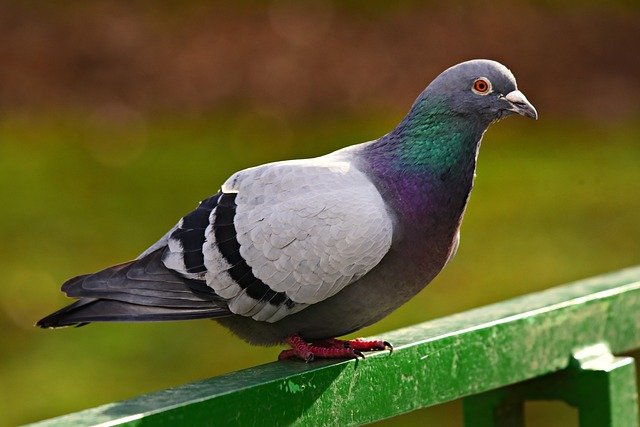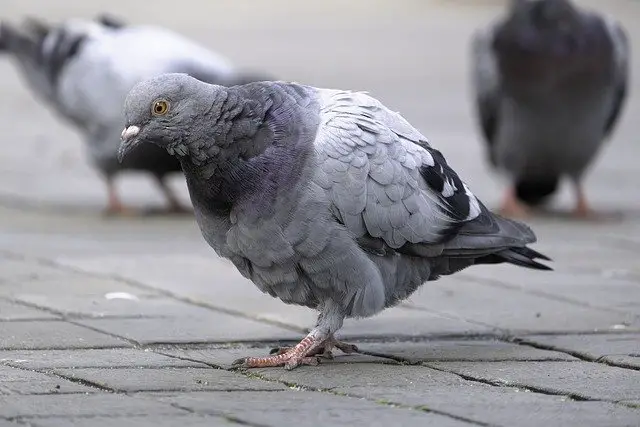As an Amazon Associate I earn from qualifying purchases.
Curious avian companions with an appetite for the eclectic – that’s how we might describe pigeons. These feathered creatures, often overlooked as mundane city-dwellers, have a dietary repertoire that surprises and intrigues. If you’ve ever pondered the question ‘What do pigeons eat?’ prepare to be astonished by the culinary choices of these adaptable birds.
Beyond the crumbled breadcrumbs and scraps of human offerings, the pigeon’s menu reads like a gourmet journey through nature’s finest provisions. In this exploration, we unveil the diverse and fascinating array of foods that make up the pigeon’s diet, shedding light on the nutritional significance of each choice.
What Do Pigeons Eat?
Often underestimated as simple city dwellers, Pigeons have a surprisingly diverse and adaptive diet. Their food preferences might appear mundane, but a closer look reveals an intricate balance between natural and human-provided sustenance. In this blog post, we’ll dive into pigeon cuisine, exploring the various foods these avian wonders consume and why each item matters.
1. Seeds: Nature’s Bounty
Seeds form the cornerstone of a pigeon’s diet. These birds have an affinity for various seeds, including sunflower, millet, safflower, and wheat. Sources provide essential nutrients like carbohydrates, proteins, and healthy fats, supporting their energy requirements for flight and survival. Pigeons are especially fond of sunflower seeds due to their rich nutrient profile.
2. Grains: Carbohydrate Galore
Just like seeds, grains are another crucial element in the pigeon’s diet. They devour grains like corn, barley, oats, and rice. These carbohydrate-rich foods sustain their energy levels, aiding foraging and daily activities. Grains also contribute to the bird’s digestive health and metabolism.
3. Fruits: Nature’s Sweet Treats
Pigeons enjoy a variety of fruits, including berries, apples, pears, and cherries. Fruits provide natural sugars for quick energy and deliver vitamins, antioxidants, and dietary fiber. Pigeons’ preference for fruits can aid in dispersing seeds across various locations, contributing to plant growth and biodiversity.
4. Vegetables: A Healthy Crunch
Leafy greens like lettuce, spinach, and kale, as well as vegetables such as carrots and peas, are also part of a pigeon’s diet. These greens offer essential vitamins like A and K and minerals like calcium, contributing to bone health and overall well-being. The added crunch of vegetables helps maintain their health by naturally wearing down their ever-growing beaks.
5. Bread: The Human Connection
One food item often associated with pigeons in urban areas is bread. While pigeons do eat bread, it’s not the most nutritious option. Excessive bread consumption can lead to malnutrition and other health issues. Bread lacks the nutrients and can fill pigeons up without providing the sustenance they need. If feeding pigeons, it’s better to offer healthier alternatives like seeds, grains, and vegetables.
6. Insects: Animal Protein Boost
Pigeons are not strictly vegetarian; they also consume insects and small invertebrates. Insects provide a protein boost that aids in muscle development, which is especially important during the breeding season. Some insects that pigeons may hunt for in their natural environment include ants, caterpillars, and beetles.
What Are the Natural Predators of Pigeons?
Despite their seemingly resilient and adaptable nature, Pigeons have their share of natural predators that play a significant role in maintaining the balance of ecosystems. These predators have evolved to prey on pigeons, helping to regulate their population and prevent overpopulation. Here are some of the natural predators of pigeons:
1. Birds of Prey:
Raptors such as peregrine falcons, hawks, and eagles are skilled hunters who target pigeons as a food source. With their keen eyesight, powerful talons, and aerial agility, these birds of prey are well-equipped to catch pigeons in mid-flight.
2. Corvids:
Birds like crows, ravens, and magpies are opportunistic predators that may target pigeon eggs, chicks, or even adult pigeons. They are intelligent and adaptable, exploiting various food sources in their environment.
3. Mammalian Predators:
Some mammals also prey on pigeons, particularly their eggs and young. This includes animals like rats, squirrels, and larger predators such as foxes and domestic cats. Rats, in particular, can be destructive nest raiders.
4. Snakes:
In regions where pigeons nest on cliffs or ledges, snakes can pose a threat. Snakes that are skilled climbers can access pigeon nests and consume eggs, chicks, and sometimes even adult pigeons.
5. Owls:
Nocturnal hunters like owls have evolved specialized adaptations for hunting in the dark. For example, Barn owls hunt pigeons during the night, taking advantage of their silent flight and acute hearing.
6. Feral Dogs and Cats:
In urban environments, feral dogs and stray cats can threaten pigeons. These domesticated animals may target pigeons for food, especially if other food sources are scarce.
7. Humans:
While humans may not be natural predators in the traditional sense, they can influence pigeon populations through actions like habitat destruction, pollution, and altering food availability. In some cases, humans intentionally control pigeon populations to manage urban nuisances.
How Pigeons Help Our Ecosystem?
Often dismissed as common urban birds, Pigeons play an essential role in various ecosystems, whether in cities or natural environments. Their contributions are often overlooked, but understanding how pigeons help our ecosystem reveals their significance in maintaining balance and promoting biodiversity. Here’s a closer look at how pigeons contribute to the ecosystem:
1. Seed Dispersal:
Pigeons are avid consumers of seeds and fruits, making them effective seed dispersal agents. When pigeons consume fruits and seeds, they often travel significant distances before regurgitating or excreting them. This process helps distribute plant seeds to different areas, facilitating plant growth and contributing to the regeneration of forests and other vegetated landscapes.
2. Plant Pollination:
While not primary pollinators like bees, pigeons can contribute to pollination when they feed on flowers and transfer pollen from one bloom to another. This activity aids in the reproduction of certain plant species, ensuring genetic diversity and maintaining plant populations.
3. Nutrient Cycling:
Pigeon droppings, or guano, are rich in nitrogen and other essential nutrients. When pigeons roost in specific areas, their droppings enrich the soil, promoting nutrient cycling and enhancing the fertility of the surrounding ecosystem. This can be especially beneficial for plants growing in nutrient-poor environments.
4. Prey for Predators:
Pigeons serve as a valuable food source for numerous predators, including raptors like hawks and owls and carnivorous mammals like foxes and wild cats. These predators help maintain a balanced food web by controlling pigeon populations and preventing their overabundance.
5. Indicator of Urban Environmental Health:
Pigeons are highly adaptable birds that thrive in urban environments. Their presence or absence can serve as an indicator of the health of urban ecosystems. Monitoring pigeon populations can provide insights into pollution levels, food availability, and overall habitat quality.
6. Educational and Scientific Value:
Studying pigeons and their behavior can provide valuable insights into avian ecology, behavior, and migration patterns. Pigeons have been used in scientific research to study navigation, communication, and avian biology.
7. Cultural and Aesthetic Value:
Pigeons have a long history of coexisting with humans and hold cultural and aesthetic value in many societies. Their presence adds to the natural ambiance of parks, plazas, and other urban areas, enhancing people’s connection with nature.
8. Pest Control:
In agricultural settings, pigeons can help control certain insect populations by consuming pests like caterpillars and beetles. While not the primary pest control method, their contribution can be a part of integrated pest management strategies.
Final Words
In conclusion, delving into the world of pigeons opens up a realm of wonderment that extends far beyond their ubiquitous presence in urban landscapes. The question “What do pigeons eat?” springs forth a captivating narrative of adaptability, ecological interconnectedness, and the subtle but essential role these birds play in our world. Pigeons demonstrate how their diverse dietary choices contribute to seed dispersal, plant pollination, and nutrient cycling in ecosystems. As we ponder the feeding habits of pigeons, we unravel a tapestry of life that illustrates how every creature, no matter how common, contributes to the intricate fabric of our planet’s vitality.
You can also read:
1.What Do Leatherback Turtles Eat? Dining in the Deep
2.What Do Great Blue Herons Eat? Dining in the Wetlands
3.What Do Gray Wolves Eat? Unveiling the Culinary Adventures
4.What Do Russian Tortoises Eat? A Guide to Their Nutritious Diet
Amazon and the Amazon logo are trademarks of Amazon.com, Inc, or its affiliates.



